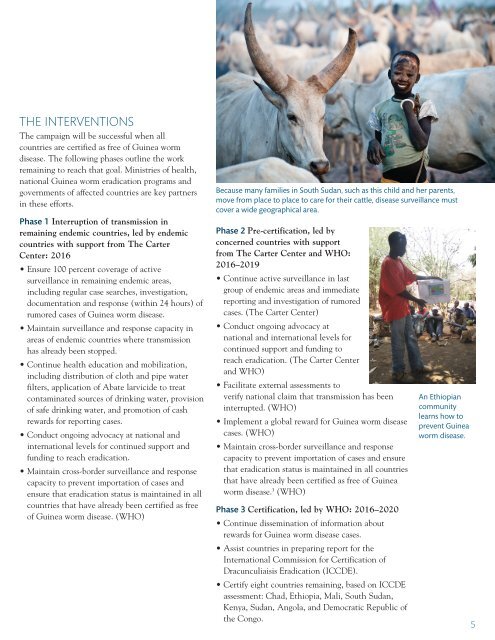ERADICATION OF GUINEA WORM DISEASE
1o72uNl
1o72uNl
You also want an ePaper? Increase the reach of your titles
YUMPU automatically turns print PDFs into web optimized ePapers that Google loves.
THE INTERVENTIONS<br />
The campaign will be successful when all<br />
countries are certified as free of Guinea worm<br />
disease. The following phases outline the work<br />
remaining to reach that goal. Ministries of health,<br />
national Guinea worm eradication programs and<br />
governments of affected countries are key partners<br />
in these efforts.<br />
Phase 1 Interruption of transmission in<br />
remaining endemic countries, led by endemic<br />
countries with support from The Carter<br />
Center: 2016<br />
• Ensure 100 percent coverage of active<br />
surveillance in remaining endemic areas,<br />
including regular case searches, investigation,<br />
documentation and response (within 24 hours) of<br />
rumored cases of Guinea worm disease.<br />
• Maintain surveillance and response capacity in<br />
areas of endemic countries where transmission<br />
has already been stopped.<br />
• Continue health education and mobilization,<br />
including distribution of cloth and pipe water<br />
filters, application of Abate larvicide to treat<br />
contaminated sources of drinking water, provision<br />
of safe drinking water, and promotion of cash<br />
rewards for reporting cases.<br />
• Conduct ongoing advocacy at national and<br />
international levels for continued support and<br />
funding to reach eradication.<br />
• Maintain cross-border surveillance and response<br />
capacity to prevent importation of cases and<br />
ensure that eradication status is maintained in all<br />
countries that have already been certified as free<br />
of Guinea worm disease. (WHO)<br />
Because many families in South Sudan, such as this child and her parents,<br />
move from place to place to care for their cattle, disease surveillance must<br />
cover a wide geographical area.<br />
Phase 2 Pre-certification, led by<br />
concerned countries with support<br />
from The Carter Center and WHO:<br />
2016–2019<br />
• Continue active surveillance in last<br />
group of endemic areas and immediate<br />
reporting and investigation of rumored<br />
cases. (The Carter Center)<br />
• Conduct ongoing advocacy at<br />
national and international levels for<br />
continued support and funding to<br />
reach eradication. (The Carter Center<br />
and WHO)<br />
• Facilitate external assessments to<br />
verify national claim that transmission has been<br />
interrupted. (WHO)<br />
• Implement a global reward for Guinea worm disease<br />
cases. (WHO)<br />
• Maintain cross-border surveillance and response<br />
capacity to prevent importation of cases and ensure<br />
that eradication status is maintained in all countries<br />
that have already been certified as free of Guinea<br />
worm disease. 3 (WHO)<br />
Phase 3 Certification, led by WHO: 2016–2020<br />
• Continue dissemination of information about<br />
rewards for Guinea worm disease cases.<br />
• Assist countries in preparing report for the<br />
International Commission for Certification of<br />
Dracunculiaisis Eradication (ICCDE).<br />
• Certify eight countries remaining, based on ICCDE<br />
assessment: Chad, Ethiopia, Mali, South Sudan,<br />
Kenya, Sudan, Angola, and Democratic Republic of<br />
the Congo.<br />
An Ethiopian<br />
community<br />
learns how to<br />
prevent Guinea<br />
worm disease.<br />
5


